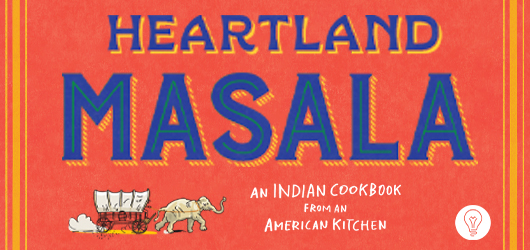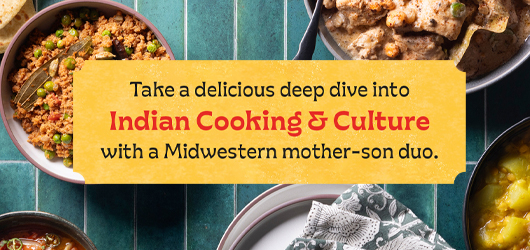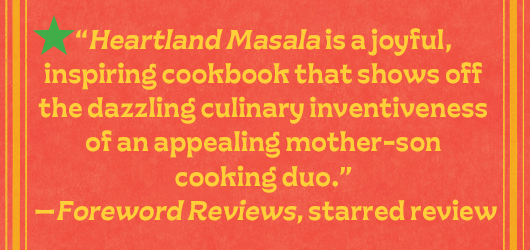Step into the Kitchen with Heartland Masala
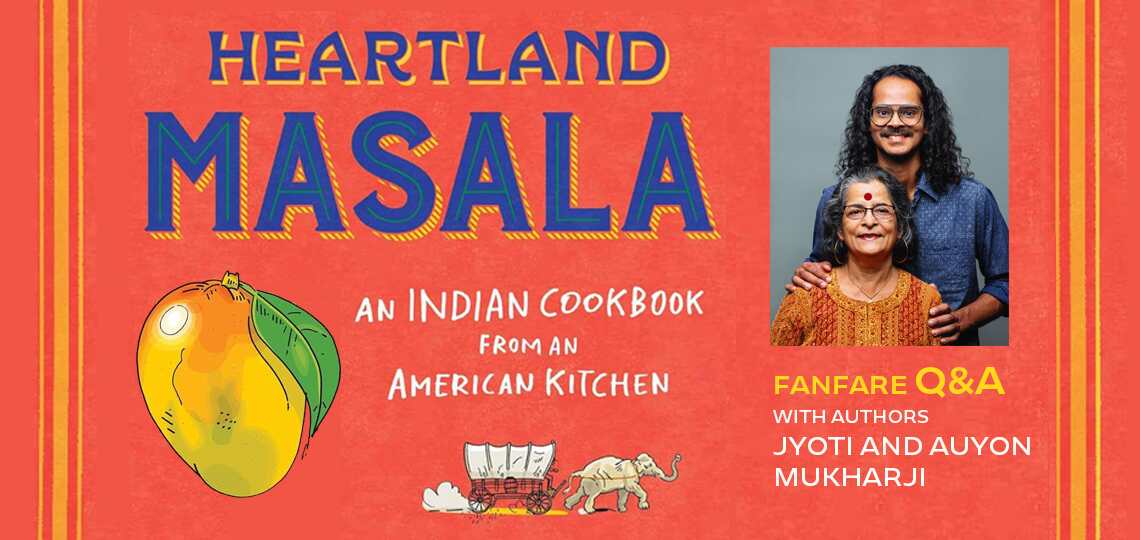
Reviewer Rachel Jagareski Interviews Jyoti Mukharji and Auyon Mukharji, Authors of Heartland Masala: An Indian Cookbook from an American Kitchen
In the minds of many Westerners, preparing authentic Indian food seems to require a plethora of inherited skills passed on from Indian mothers to their children—not to mention a complete overhaul of your spice cabinet and pantry. Such is the lingering mystique about Indian cuisine, one that tends to intimidate even the most adventurous home cook.
Jyoti and Auyon Mukharji, the magnetic mother and son team behind Heartland Masala: An Indian Cookbook from an American Kitchen, would like to disabuse you of that idea. Their validation is in the thousands of amateur cooks Jyoti has taught in the American Midwest over many years. The book is a culmination of all those lessons and features a wealth of Indian culinary history, witty commentary, and dozens of regional recipes.
In her starred review in Foreword’s September/October issue, Rachel Jagareski calls Heartland Masala a “joyful, inspiring cookbook that shows off the dazzling culinary inventiveness of an appealing mother-son cooking duo.” We quickly connected the authors and reviewer for a heartwarming conversation.
As a mother and son author team, what was it like to collaborate on this cookbook project? Do you have different cooking styles and palates?
AM: First, thanks so much for having us here!
I’m often asked by friends and acquaintances what it was like to work with my mother on the cookbook. I like to reply with a couple queries of my own: 1) Do you have a mother? 2) If so, can you imagine what it would be like to spend eight years of your life on a creative project that you’re deeply invested in alongside her?
My return volley typically prompts a look of shock, an agonized sigh, or a softly-muttered admission that “one of us wouldn’t have made it.” All of these are appropriate responses.
My mother is a powerful woman with strong opinions. I too have many deeply-held beliefs. While there were many beautiful aspects of working together—and even though both of us are now immensely proud of the book—our writing process could not accurately be described as nonviolent.
The most difficult bit was the recipe testing, wherein my mom equated my admittedly blunt recipe criticism with mistrust. She usually responded by emphasizing my relative inexperience. It got ugly frequently enough that we built time for fights into the schedule so that we could finish the thing on time. To be fair, the actual writing process (which was largely my domain) and the photo shoot (which was my mom’s) were both much smoother going. The key, I think, was having an established hierarchy. Where it got thorny was when we treated each other as equals. I am not, I now understand, my mom’s equal. Ever.
JM: I want to say we had more fun than arguments, anger, or tears. I feel all of these sentiments are just part of the collaborative process. The first few days of recipe testing always started on a cool note. Then, as we went along, the emotions would start to build up and culminate in tears or anger on my part (and just anger on Auyon’s).
We do have different cooking styles. I like to clean as we go along and I don’t like to measure. I also use very few utensils when I cook. Auyon, on the other hand, is a measuring fanatic and simultaneously extremely messy. When he cooks, the sink gets piled high with lids, pots, pans, measuring cups, mixing bowls, spoons, more pots, etc. It is difficult to look at.
Palate-wise, Auyon prefers his sweet chutneys less sweet, whereas I like them really sweet (even though he is a much bigger fan of desserts than I am). Otherwise our tastes are quite similar.
Jyoti, what are some of the most popular dishes with your culinary students and why?
JM: The most popular dish I teach is Butter Chicken, without a doubt. I advertise a series of three classes featuring this dish once a year, and it always sells out within a day or two. The runner-up is my street food classes, which are largely vegetarian. Since these dishes are mostly small plates and finger foods, they are a joy not only to make, but also to serve and eat together.
When I get set to prepare a meal, I must have a stack of cloth dish towels at my side. What is essential kitchen gear for each of you in your mise en place?
JM: I don’t know whether this qualifies as gear or not, but I must have a clean kitchen (and kitchen sink) always, even while cooking. Having cooked for as many years as I have, in conjunction with my fifteen years of teaching, I like to think that I have my cooking and cleaning down to an art. My other essentials: dish cloths, an apron, a slotted spatula, a ladle, a ginger grater, sharp knives, a spice grinder, and a wok for frying.
AM: My favorite piece of cooking gear is my apron. It is also my favorite piece of clothing. In a pinch, it’s: a napkin, a dish cloth, a shirt, and (kind of) a pair of pants, at least when viewed from the front. (This is the apron I’ve owned and loved since 2020—the company doesn’t sponsor me or otherwise know I exist, but I shill for them anyway.)
Most Americans tend to think of Indian cuisine in terms of spicy curries or tandoori dishes. Your book has such a wide collection of sweet desserts and drinks. Tell us more about the tradition of Indian sweets.
JM: Indian sweets are quite variable in both form and makeup, depending on which part of India you are from. In the north we use wheat or gram (black chickpea) flour, carrots, yogurt, and even lentils. In the east, sweets are often milk-based. In the south and west, yogurt is predominantly used, but there are a lot of overlapping of ingredients too. Green cardamom, saffron, rosewater and kewra (screwpine flower) water are flavorings used across the continent.
AM: There’s such a beautiful, and indescribably broad, range of sweets in India. Halwa, an Arabic loanword that spans dairy-free flour-, fruit-, vegetable-, nut-, and legume-based confections within India, is a universe unto itself. (Outside of India and especially in the Levant and surrounding areas, the term halwa, or halva, often refers specifically to tahini-based preparations.) Then you’ve got jalebi, a knotted spiral of deep-fried, syrup-coated batter that tastes like a hot, juicy, crisp-edged dream. There are the many dairy-based confections that Bengal is famous for (referenced by my mom above), which some historians trace back to the Portuguese introduction of cheesemaking in the late 15th century. The British left their mark too, in the form of Anglo-Indian confections like flans and fruit creams, both of which feature in our cookbook.
I would be remiss if I neglected the vast breadth of fruit available on the subcontinent: lychees, guavas, pomegranates, custard apples, coconuts, and, of course, the undisputed queen of South Asian fruiting flora, the mango. Perhaps not a dessert in the traditional sense, but in season, a plate of mango is often what’s on offer (and more importantly, what you want) after every meal.
What is your favorite dish to make for guests or a celebratory feast?
JM: This is a really tough question for me. I love to cook, and I especially enjoy making a broad range of dishes when hosting friends and neighbors in our home. That said, I can highlight a couple of favorites: Bengali khichudi, which is a mix of rice and lentils traditionally topped with crispy fried eggplant, is both simple and beautifully festive. A wonderful brunch is loochi (or puri, a fried balloon bread) with a potato-tomato curry and chickpeas. My favorite meat dish to make for a group is probably mutton aloo korma (goat meat curry with potatoes).
AM: I don’t really have a stable of dishes that I make consistently. For celebratory occasions, I am most inspired by in-season fruits and vegetables—ideally ones that I’ve found myself. (I started foraging during the pandemic and am now hooked.) I recently made a slew of nettle-based dishes for some friends in the UK, and also helped out with a lemon-gorse ice cream that came out really nicely. I’m otherwise a big fan of organ meats.
Conversely, when time and energy are in short supply, what is your go-to quick meal?
JM: Rice, lentils, and bhaja (vegetable fritters made with potatoes, okra, eggplant, or bitter gourd).
AM: An even tie between: 1) tinned fish eaten straight from the can; 2) leftovers with a poached egg on top; and 3) sharp cheddar, crackers, and sauerkraut.
I love the injections of humor in your text and illustrations. Do you think we all need to be more light-hearted and playful in the kitchen?
JM: I absolutely think playfulness in the kitchen is a must. The importance of levity has become especially clear to me through my classes. I know my students love my food, but I think people keep coming through because of how much fun we have—I’ve hosted over 6,000 folks through my kitchen, all via word-of-mouth with no advertising!
AM: Thanks for the kind words on the humor in the book, too! We had such a good time putting those illustrations together with our illustrator, Olivier Kugler. He’s a dream of a collaborator, and he really captured the bittersweet quality of our prose with his artwork. Heartland Masala is a serious book about Indian cooking, history, and culture, but it’s also a book with a technicolor cartoon unicorn surfing a fruit rainbow. That dark-light dichotomy was something I thought about a lot while writing the book, and I’m so pleased that we stuck the landing.
Heartland Masala: An Indian Cookbook from an American Kitchen
Jyoti Mukharji
Auyon Mukharji
The Collective Book Studio (Sep 9, 2025)
Spicy flavors zing through Heartland Masala, a delightful cookbook by mother-son team Jyoti and Auyon Mukharji.
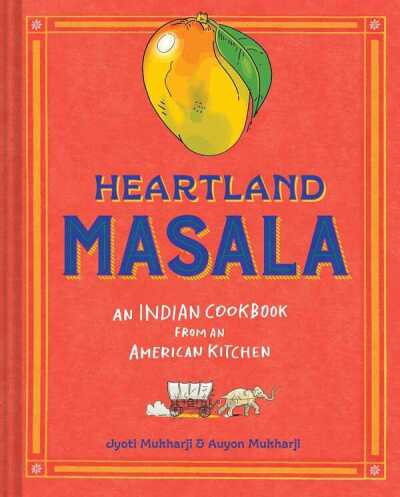
Recreating traditional Indian dishes in American kitchens, the book combines culinary history and commentary with a wealth of regional recipes. Spices are central to its work, which includes ample advice on tempering them in hot oil or ghee and on how to make spice mixtures. A descriptive addendum on the usage and storage of numerous spices, from amchoor to turmeric, is also included.
Plenty of Indian favorites are here, including samosas, butter chicken, and mango lassi, but fusion dishes abound too. American Masala Brussels Sprouts with potatoes and ground dried mango; fresh corn meets ginger, lemon, and cilantro in Bhutta Chaat; and cubes of watermelon are dressed with kalonji and warm-flavored spices infused in hot oil. Further, a wealth of bean dishes proves perfect for meatless and budget-conscious home cooks.
The ingredients, gear, and techniques needed for each recipe are described with playfulness and panache. Most recipes involve just a supermarket trip, but there are some dishes that require sourcing ingredients elsewhere. For instance, Murgh Rezala calls for white poppy seeds, kewra water, and water lily seeds.
Lighthearted illustrations add wit and valuable information on how to prepare vegetables, identify legumes, and shape breads. Plentiful color photographs reflect how the finished dishes should look. The Mukharjis’ effervescent personalities sizzle in the recipe introductions and are further reflected in their illustrated selves and captioned banter, as when Jyoti has the last word over Auyon on the deep-frying of beloved snacks: “Ignore him. Fry deeply.”
Heartland Masala is a joyful, inspiring cookbook that shows off the dazzling culinary inventiveness of an appealing mother-son cooking duo.
Reviewed by Rachel Jagareski
September / October 2025
Rachel Jagareski

